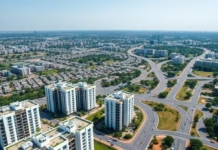Compact Homes Drive Mumbai 2024 Real Estate Market, Affordability Key Factor
Mumbai’s real estate market in 2024 has witnessed a strong preference for compact housing, with 50% of newly registered properties measuring less than 650 sq ft, according to data from the Maharashtra Real Estate Regulatory Authority (MahaRERA). Nearly 60% of the newly launched units comprise 1 BHK and 2 BHK apartments, reflecting a market driven by affordability and evolving homebuyer preferences. Despite this trend, the average apartment size has seen a gradual increase over the past five years, with the supply of larger apartments ranging between 650 sq ft and 1,300 sq ft nearly doubling in the last four years. The market remains resilient, as 63,244 units were registered in Mumbai in 2024, a 4% rise from 2023, though significantly lower than the peak of over 75,000 units launched in 2022. Industry experts suggest that while affordability remains a primary concern, there is a growing aspiration for larger homes, particularly 3 BHK and above, as buyers seek long-term value and lifestyle upgrades.
The data reveals a shift in demand dynamics, with a declining supply of 1 BHK apartments over the past three years. In 2022, over 21,000 such units were registered, but this number fell to 18,000 in 2023 and around 15,000 in 2024, suggesting a market tilt towards larger configurations. While 1 BHK and 2 BHK homes continue to dominate the housing supply, around 15% of the new launches comprised 3 BHK apartments, with 4 BHK units making up nearly 3% of the total. Additionally, the commercial real estate segment reported over 6,200 office spaces and shops, accounting for 10% of total property registrations in 2024. Market analysts attribute this evolution to shifting homebuyer aspirations, income growth, and changing work-from-home trends that have influenced the need for larger living spaces. At the same time, Mumbai’s premium housing market remains strong, with luxury homes fetching prices between ₹20,000 per sq ft to ₹1.60 lakh per sq ft, with select transactions exceeding this range, such as Uday Kotak’s recent purchase of 12 sea-facing Worli apartments for ₹202 crore, valued at over ₹2.70 lakh per sq ft.
Peripheral locations have emerged as hotspots for new housing developments, with areas such as Kurla East, Bandra West, Vile Parle East, Andheri East, Malad, Ghatkopar East, Bhandup West, Vikhroli, Borivali West, and Kandivali East witnessing a surge in launches. Bhandup West, Mulund West, Borivali West, Malad East, and Oshiwara recorded the highest number of new housing units, each surpassing 1,000 launches. The bulk of new developments—90% of the total—were concentrated in North and Central Mumbai, particularly in Dadar and Sion. According to Pune-based real estate analyst Rahul Ajmera, the number of units registered in 2024 reflects a post-pandemic revival in Mumbai’s property sector, with registration volumes surpassing pre-2019 levels despite being 15% lower than the 2022 peak. He further highlighted the role of policy interventions such as a 50% discount on premiums, relaxation of Coastal Regulation Zone (CRZ) norms, and stable market conditions in bolstering housing supply and sales momentum over recent years.
From a sustainability perspective, the preference for compact homes aligns with the need for optimised land use, lower resource consumption, and reduced environmental impact. Smaller homes inherently promote energy efficiency and lower carbon footprints, especially in a high-density city like Mumbai. However, the rapid expansion of housing projects in peripheral areas raises concerns regarding infrastructure readiness, public transport connectivity, and overall urban planning. Experts stress that while compact housing addresses affordability and optimises available space, it must be accompanied by investments in sustainable infrastructure, green building norms, and smart urban planning to ensure long-term liveability. With the market continuing to evolve, balancing housing affordability with sustainability will be key to shaping Mumbai’s real estate landscape in the coming years.







